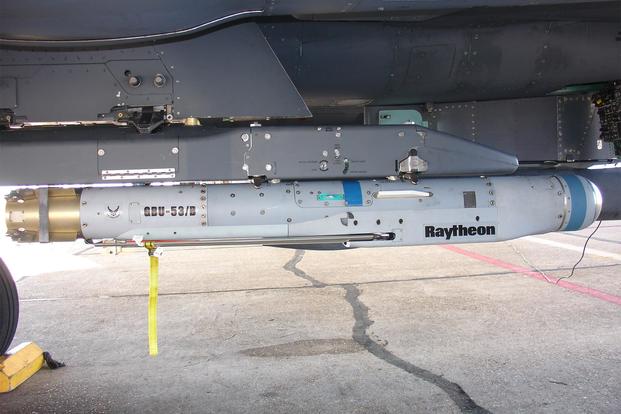FARNBOROUGH, England -- Testing for Raytheon’s Stormbreaker precision-guided bomb, which can go after moving targets in bad weather, is "going so well" it may be fielded earlier than expected, according to company officials.
The U.S. Air Force's System Programs Office "is looking at [the bomb and saying], 'This is going so well' that they're pulling the timeline left because they want to potentially field it early," said Jim Meger of Raytheon's Missile Systems business development. Meger spoke to Military.com Tuesday during an interview at the Farnborough air show here.
"No matter how challenging a scenario we've put into it, the weapon is performing just fantastic," Meger said.
Meger said fielding to some aircraft may take place "right on the edge of 2018, 2019, is kind of where [officials] are looking."
Related content:
- The US Just Flew a Stealth Fighter to Bomb Drug Labs in Afghanistan
- Army to Buy Raytheon's Coyote Expendable UAS for Drone-Killing Mission
- Military.com Farnborough Airshow Coverage
The F-15E Strike Eagle, Navy F/A-18 Super Hornet and F-35 Joint Strike Fighter are all expected to carry the bomb. While the legacy fighters may get the StomBreaker earlier, the F-35 is not expected to carry it until roughly 2022, officials said. The Air Force, which classifies the bomb as the GBU-53, is the lead service on the program.
"We're working as hard as we can to pull that [fielding] to the left," Meger said.
Raytheon officials this week announced that StormBreaker has entered operational testing.
"And we've taken eight operational test shots," Meger said, adding the most recent test occurred last week.
Meger said the bomb's success rate was 90 percent during developmental testing.
StormBreaker, a 250-pound-class attack weapon, uses a millimeter wave radar to see through any kind of weather. A fused imaging infrared seeker on the front of the bomb helps to classify targets. While it uses a more common GPS-coordinate target system, the bomb may also carry a laser to more precisely outline a target.
Two antennas on the bomb allow it to connect via the common Link 16 datalink as well as through ultra-high-frequency communications. Meger said the comms equipment allows pilots to send new information to the weapon in flight, which helps with tracking targets in bad weather.
"The beauty of StormBreaker is that it actually seeks out and will find and classify a target for you instead of just hitting a coordinate," said Meger, who was the former 9th Air Expeditionary Task Force vice commander.
The bomb may also be used against moving maritime targets, he said.
An F-35 can carry 24 total StormBreaker bombs, eight internally and 16 externally. The bombs were previously known as small diameter bomb, or SDB, IIs.
"Imagine....they have to defend against swarming boats. You can start sending a whole bunch of the SDB IIs out to go find those boats as you're providing information to them, data linking to them," he said.
The StormBreaker's predecessor, Boeing-made GBU-39 SDB I, uses similar precision-guided technology, but lacks the advanced moving-target seeking equipment. The GBU-39 is used as a low collateral-damage weapon, often in urban environments.
With StormBreaker, "you can tell it, 'I'm looking for a tracked vehicle.' And it will classify the different targets for you ... and goes, 'That's what you're looking for,'' Merger said. "That's a huge quantum capability leap."
-- Oriana Pawlyk can be reached at oriana.pawlyk@military.com. Follow her on Twitter at @oriana0214.










